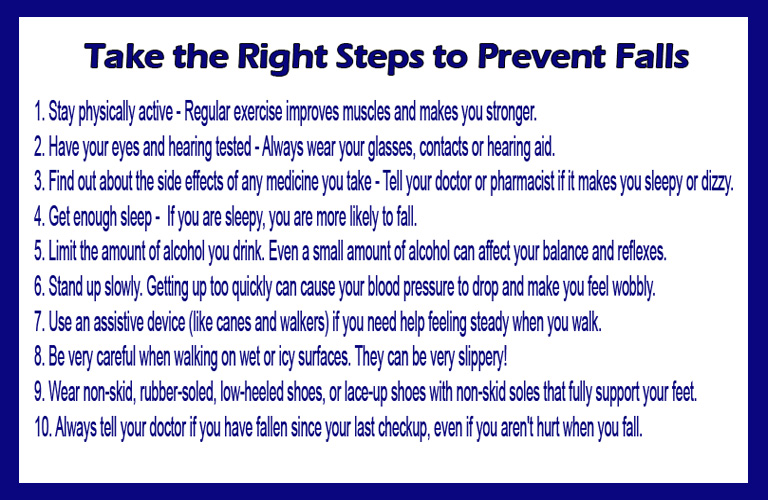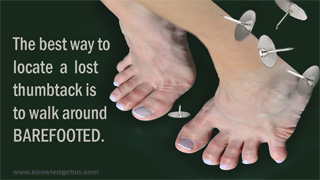Home Improvements Prevent Falls
Many governments have education and/or home modification programs to help older adults prevent falls. Check with your local health department or senior help office in your area to see if there is a program near you. There are many changes you can make to your home that will help you avoid falls and ensure your safety.
Changes You Can Make:
In Stairways, Hallways, and Pathways
- Install handrails on both sides of the stairs, and make sure they are tightly fastened. Hold on to the handrails when you use the stairs. If you must carry something up or down stairs, hold it in one hand and grip the handrail with the other. Don't let what you're carrying block your view of the steps.
- Make sure there is good lighting with switches at the top and bottom of stairs and at each end of a hall. Remember to use the lights!
- Keep stairs, halls, walkways, and floors free of clutter. Don't leave books, papers, clothes, and shoes lying in harm's way.
- Firmly affix all carpets to the floor, so they won't slip. Put no-slip strips on tile and wooden floors.
- Don't use throw rugs or small area rugs.
In Bathrooms and Powder Rooms
- Mount grab bars near toilets and on both the inside and outside of your tub and shower.
- Place non-skid mats, strips, or carpet on all surfaces that may get wet.
- Install shower chair.
- Install raised toilet seat if needed.
- Remember to turn on nightlights.
In Your Bedroom
- Put nightlights and light switches close to your bed.
- Keep your telephone and a flashlight within reach.
In Other Living Areas
- Run extension cords and telephone wires along walls and away from walking paths.
- Tack down all carpets and large area rugs.
- Arrange your furniture (especially low coffee tables) and other objects so they are not in your way when you walk.
- Make sure sofas and chairs are the right height, easy to get in and out of.
- Avoid walking on newly washed floors—they are slippery.
- Keep items you use often within easy reach.
- Never stand on a chair or table to reach something that's too high. Use a stepstool or stepladder instead, or a "reach stick."
- If you have to use a step stool, make sure it is steady and has a handrail on top. Have someone stand next to you.
- Don't trip over your cat or dog. Know where your pet is before standing or walking.
- Keep emergency numbers IN LARGE PRINT near each telephone.

Take the Right Steps to Prevent Falls
1. Stay physically active - Regular exercise improves muscles and makes you stronger.
2. Have your eyes and hearing tested - Always wear your glasses, contacts or hearing aid.
3. Find out about the side effects of any medicine you take - Tell your doctor or pharmacist if it makes you sleepy or dizzy.
4. Get enough sleep - If you are sleepy, you are more likely to fall.
5. Limit the amount of alcohol you drink. Even a small amount of alcohol can affect your balance and reflexes.
6. Stand up slowly. Getting up too quickly can cause your blood pressure to drop and make you feel wobbly.
7. Use an assistive device (like canes and walkers) if you need help feeling steady when you walk.
8. Be very careful when walking on wet or icy surfaces. They can be very slippery!
9. Wear non-skid, rubber-soled, low-heeled shoes, or lace-up shoes with non-skid soles that fully support your feet.
10. Always tell your doctor if you have fallen since your last checkup, even if you aren't hurt when you fall.
The more medications you take, the more likely you are to fall.
Did You Know?
Falls by seniors in the home, such as on stairways, are among the most common and dangerous accidents.Over 95 percent of hip fractures are due to falls.
Older women are more than twice as likely to fracture their hips in falls as older men.
More men are likely to die from falls than women.
People 75 and older who fall are much more likely to be admitted to long-term care facilities for a year or more.
Falls by seniors are largely preventable, with the right preparations.
Regular exercise improves muscles and makes you stronger. It also helps keep your joints, tendons, and ligaments flexible.
Mild weight-bearing activities, such as walking or climbing stairs, may slow bone loss from osteoporosis.
Appropriate use of canes and walkers can prevent falls. If your doctor tells you to use a cane or walker, make sure it is the right size for you and the wheels roll smoothly.
Never walk on stairs or floors in socks or in shoes and slippers with smooth soles. Wear non-skid, rubber-soled, low-heeled shoes, or lace-up shoes with non-skid soles that fully support your feet.





